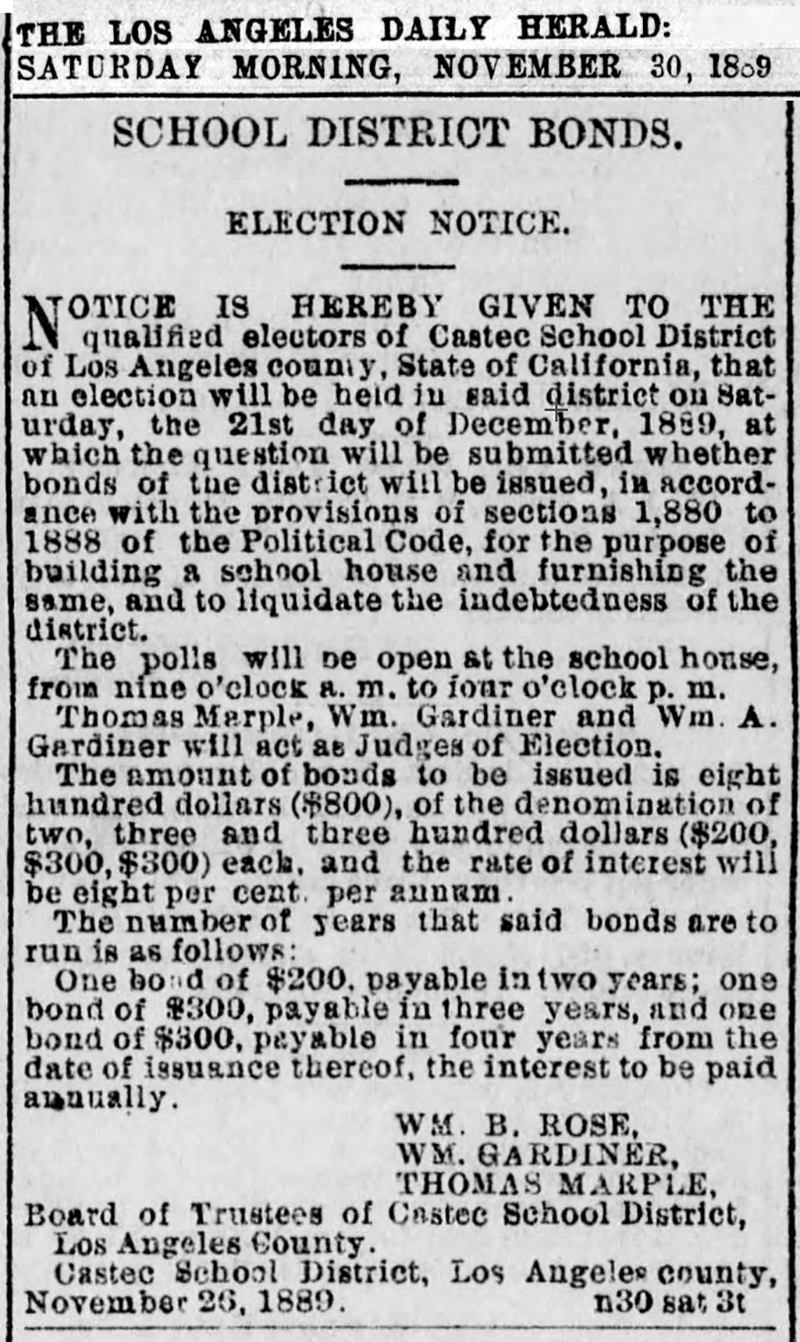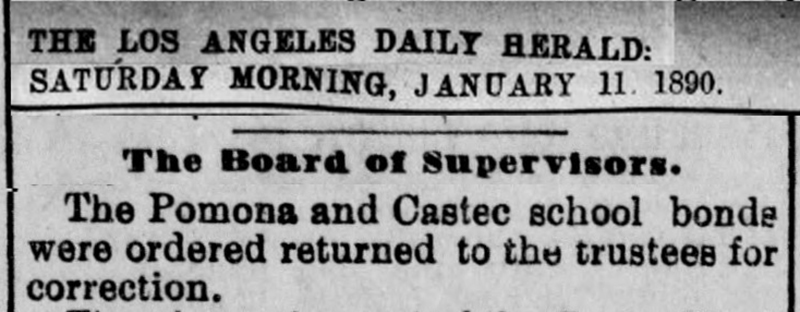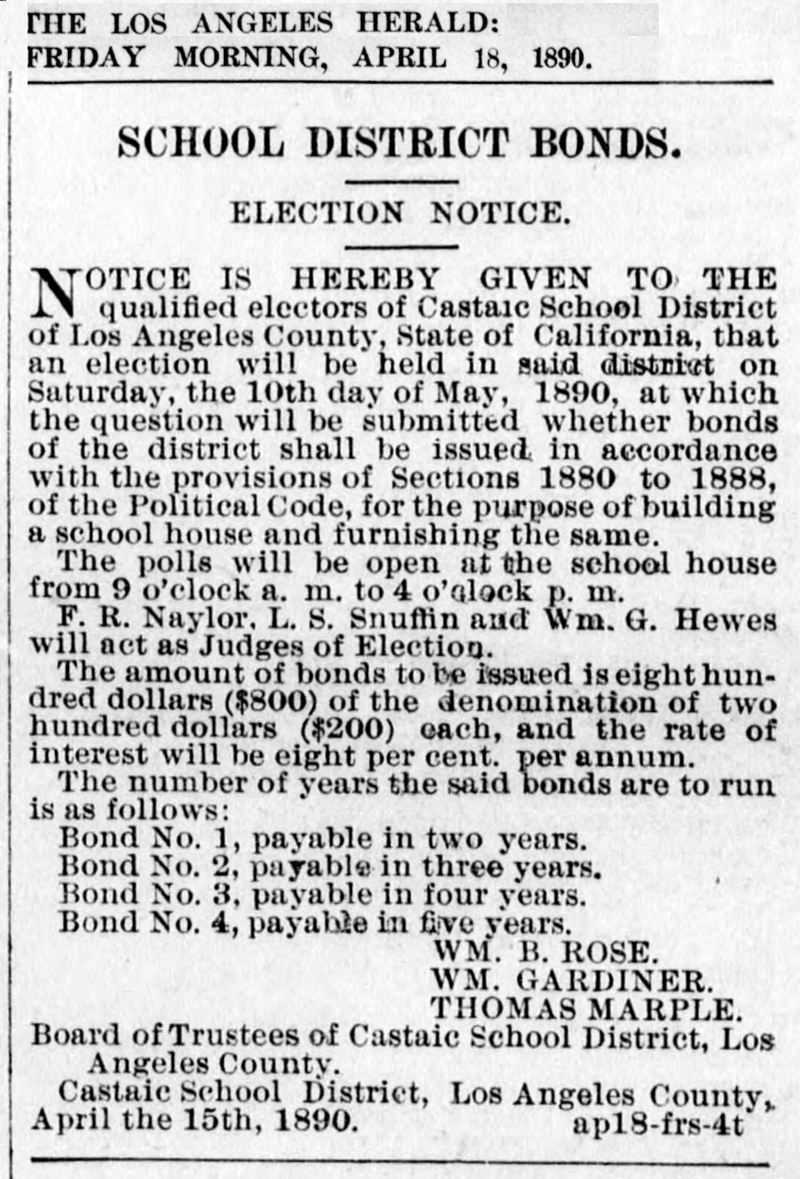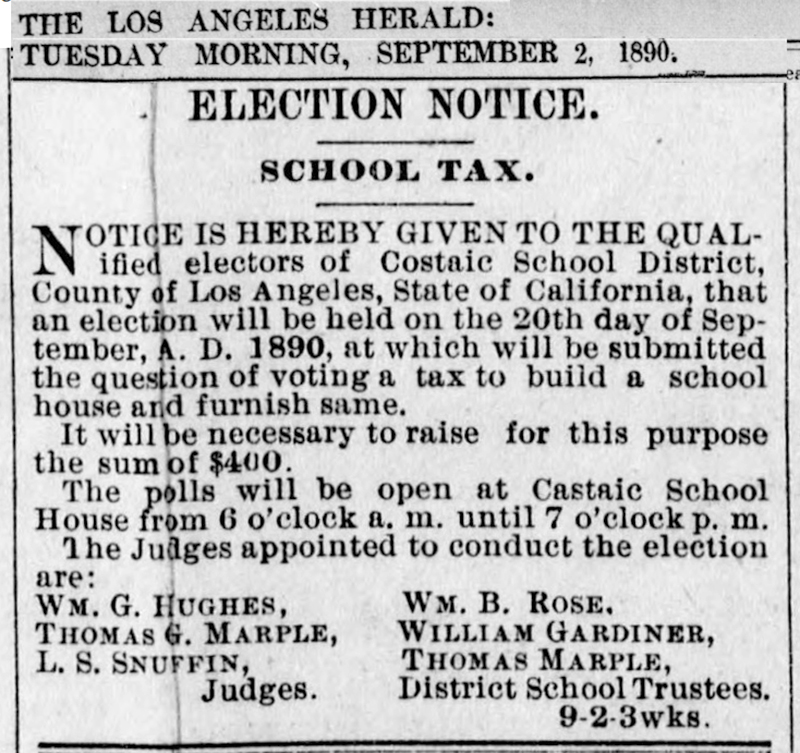|
At the very moment a nascent land dispute in Castaic turned into an all-out range war that lasted 16 years and snuffed out as many as 21 lives, partisans on the side that fired the first deadly shots tried to float one of the Santa Clarita Valley's earliest school construction bond measures.
Talk about lousy timing.
By way of background, L.A. vigilante lawman William W. Jenkins came to the SCV in the 1860s and set up a large ranch in Castaic in 1872. Dial up the clock to about 1887: Santa Paula rancher William Chormicle arrived on scene holding title to much of the same land and planted his flag.
You were either with Jenkins or against him. In nearly 20 years, Bill Jenkins had given plenty of local ranchers cause to dislike him.
One of them was William Blackburn Rose, who had a ranch just south of today's Castaic Lake Reservoir. He was a business partner of José Jesús Lopez, E.F. Beale's ranch foreman up at Tejon. Years later, Rose's son William Jr. (Billy Rose) would shoot Jenkins off his horse. Jenkins survived.

Click each image to enlarge.



|
Another was William Gardiner, whose ranch adjoined Chormicle's in Castaic Canyon. It was Gardiner's son, William A. Gardiner, who joined Chormicle on the day the Castaic Range War turned fatal. On February 28, 1890, Chormicle and young Gardiner lay in wait as Dolores Cook and George Walton rode across some disputed land and shot them down. Dead men tell no tales; Chormicle and Gardiner claimed self-defense and were eventually acquitted.
Thomas Marple's alliances aren't as well known, but one can make suppositions. He married into the Martinez family of today's Val Verde area. After homesteading land on the south bank of the Santa Clara River between Piru and Fillmore in the 1880s, he homesteaded in Hasley Canyon in the 1890s. His wife, Leovijilda Martinez Marple, had land of her own, northeast of today's Castaic High School. The latter is where Marple Canyon gets its name. Thomas Marple had assisted Chormicle in pressing authorities to keep Jenkins off Chormicle's land and ultimately testified in his defense.
William B. Rose (Sr.), William Gardiner (Sr.) and Thomas Marple were the original governing board members of the Castaic School District.
Under the law at the time, school districts had only three board members. ("Union" school districts, meaning the union, or merger, of two or more districts, had five board members.)
We haven't seen the organizing documents, but historian Jerry Reynolds tells us the Castaic School District was formed March 25, 1889 (Reynolds 1992:80). We do know later the same year, Rose, Gardiner and Marple set about to build a school. Seeking to raise $800, they drafted a school bond measure and published a legal notice the prescribed number of times in the Los Angeles Herald newspaper, announcing an election date of December 21, 1889.
But there was a problem. We don't know exactly what the problem was, but the Los Angeles County Board of Supervisors rejected their bond measure petition. According to a January 1890 notice in the Herald, it was "returned to the trustees for correction."
A couple of potential problems stand out. One is the spelling of the name, "Castec." When the petition was resubmitted, it became "Castaic." The misspelling is understandable; "Castaic" derives from the Tataviam word, Kashti'q, meaning "like an eye," and Mexicans and Americans spelled it various ways. The 1843 Mexican land grant in the Lebec area was "Rancho Castec;" the original (natural) Castaic Lake at Lebec was often spelled "Castac" Lake. And then there are typographical errors: One of the school organizers' legal notices spells it "Costaic."
It's doubtful spelling was the main problem. Under their original 1889 petition, the judges — the counters of the ballots — were to be Marple, Gardiner, and Gardiner's son William A. Gardiner. The fox was to guard the henhouse.
On March 10, two months after the supervisors canceled the election, William A. Gardiner and his mentor came out of hiding and surrendered for the slaying of Dolores Cook and George Walton. The pretrial hearing resulted in their being remanded to jail pending trial for double murder.
Two weeks later, Gardiner's father and the other two school board members refiled their bond measure petition. This time, it named independent election judges: F.R. Naylor, a rancher in Elderberry Canyon (above the left arm of the current Castaic Lake Reservoir), L.S. Snuffin and William G. Hughes (misspelled Hewes). (We're unfamiliar with latter two; this was not the Hughes of Lake Hughes.) The new petition called for a bond election May 10, 1890.
It probably wasn't the best time for partisans of murder suspects to ask for votes, no matter how beneficial the issue. Dozens of would-be voters were too busy being prepared as witnesses throughout April and May. Election Day came and went. All of Castaic's attention was riveted to the Los Angeles County Superior Court. Trial started at the end of May and lasted three weeks.
Our story takes a peculiar little twist June 2 when Chormicle's son, Robert E. Chormicle, was arrested on suspicion of stealing some school books belonging to the nearby San Francisquito school district. The Chormicles must have really wanted their kids' schooling to start. Robert was hauled into the courtroom of — guess whom? — Justice Bill Jenkins.
In September, the Castaic school construction effort was reborn as a tax election with a lower price tag. No longer would $800 be raised through the sale of bonds at 8 percent interest, as in the two earlier proposals. Now voters were asked to approve just $400 (total) in direct taxes.
Castaic finally got a schoolhouse. Another school in the area, Live Oak, came along in 1915. (There was also a Martinez school, but we know nothing about it.) During the 1928-29 school year, the Castaic School District that Rose, Gardiner and Marple started in 1889 merged ("united") with the Live Oak School District to become the Castaic Union School District we know today — and Castaic got a five-member school board.
Land disputes continued in Castaic, but not to such deadly effect.
| 